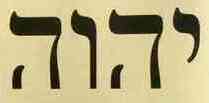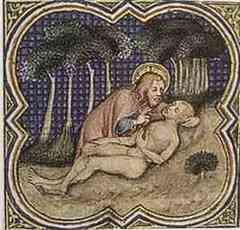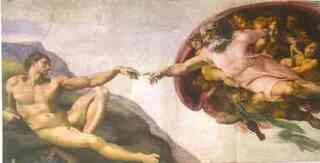 Home
News
Vision
The 7 Phases
Esoteric Evolution
Books
Articles
Related articles
The counterforces
About Margarete
Quotes / Test
Links / Contact
Home
News
Vision
The 7 Phases
Esoteric Evolution
Books
Articles
Related articles
The counterforces
About Margarete
Quotes / Test
Links / Contact
|
Esoteric Evolution - 13Yahweh and the Second CreationThe previous chapter relates how Bible exegetes have been busy for centuries trying to explain the differences between the creation stories in Genesis1 and Genesis 2. To this day, they have not succeeded in doing this convincingly. Esoteric Christianity shows that in actual fact there is no inconsistency. The events in Genesis 2, which took place much later in evolution, are a completely logical sequel to those in Genesis 1. Yes, they turn out to be a direct continuation of the latter. This can only be understood if we accept that human evolution took place along two different paths, namely on the one hand, the development of the corporeality of the human being, in other words, the gradual coming into being of the physical, etheric, and astral bodies. On the other hand, there was the human spirit which, descending out of high spiritual heights, sought a home in this physical housing to go through its development on earth. At a certain moment, both came together in the I. From that coming together a long developmental process arose resulting in the human beings we now are, uniting heaven and earth, spirit and matter with each other. The overview in the previous chapter with the descending line of the spirit (no. 1) and the rising line of corporeality (2) shows both paths as different processes in time. The difference between Genesis 1 and Genesis 2The creation process in Genesis 1, says Rudolf Steiner, shows the development of corporeality (2) as this took place during the "six days of creation." At that stage there was as yet no connection between spiritual and physical development. That which would later become the spirit working in the human being was still living outside this becoming corporeality, not yet within it. Genesis 1 takes place during Hyperborea and in the first half of Lemuria. By contrast, Genesis 2 speaks of the moment when both paths of development - that of corporeality and that of spirit - came together and connected with each other. That happened in the second half of Lemuria. Genesis 1 ends with the creation of the human being on the "sixth day." The sixth day encompasses the period when the Elohim proceeded to imprint the archetypal form of the human figure into the purified astral body. The astral body was thus made able to become the bearer of a human I and a human spirit. This imprinting of the human figure and its effect in corporeality is what the Bible means when it is said that the human being was created in the image of God, in other words, in the image of the Elohim. The Elohim and ChristThe previous chapter also describes that the creation of the human being on the sixth day demanded an enormous increase in the creative power of the Elohim. For only by a greatly increased and united effort and spiritual power of the combined Elohim was it possible for the Sun Logos, the Creative Word, to create the human being through them. The Sun Logos, Christ, is God the Son and, as such, is part of the Trinity from which all that exists has come into being. As enormously high creative beings, the Elohim are the implementers of the Sun Logos on earth. Wherever they work the Sun Spirit, the Creative Word is also present and active. That holds true especially for everything connected with the creation of human beings, their I and their connection with the spirit. Resting on the seventh dayThe high creative work on the human being on the sixth day was the reason why the seven Elohim transformed into a higher unity. This unity became so strong that it created a heightened consciousness of unity. Directly after the sixth day has been described, the Bible begins with Genesis 2 and relates that God withdrew on the seventh day and rested of the work he had done. What happened here, viewed esoterically? Out of this new unity-consciousness that the seven Elohim formed with each other, one part split off after the sixth day. This separate part of the Elohim kept working most directly on the earth. The other part, the remaining six Elohim, withdrew to the Sun in order to work from there, and to inwardly prepare for subsequent developmental steps on earth. This withdrawal by the six Elohim from direct creative work, says Rudolf Steiner, is what is meant when it is said that God rested on the seventh day.
Yahweh, Jehovah or also Yahweh-Elohim is written as Tetragram and consists of 4 letters - Yod, He, Waw, He - which are read from right to left. Genesis 2 and Yahweh-ElohimThe part of the unity-consciousness of the Elohim that kept working on the earth is called Yahweh-Elohim, or briefly Yahweh. He is the subject of Genesis 2. This is evident from the change of the term used for "God." Suddenly the Bible doesn't speak of "God" anymore but of "the Lord God." That is because the original Hebrew text no longer uses the word Elohim there, but Yahweh or Adonai, the name of the Eloah that was working directly on the earth, Yahweh-Elohim or Yahweh. In Genesis 2, this is the one who continues the work of the seven Elohim on the human being described in Genesis 1. Because of his special connection with the Jewish people, Yahweh is also called "the God of Israel." Afraid to desecrate his name, the Jews abbreviated his name to YHWH and pronounced it as Adonai, Lord. Genesis 2:5Genesis 2: 5 describes that there were not yet any plants or bushes growing on the earth, because the Lord God had not yet caused it to rain on the earth, and there were no human beings to cultivate the land. That was not yet possible. As is described in the previous chapter, during the six days of Genesis 1, the creative process only generated the species, the archetypal forms of the plants. Separate bushes and plants came only later into being. Rain was also impossible, for the separation of the elements air, water, and earth had not yet taken place. That only happened during Atlantis. And it is also understandable that there were not yet any human beings to cultivate the land. After all, that is only possible if human beings possess a corporeality with a skeleton and bones, and the earth consists of hard, mineral matter. That was not yet the case at that time. The materiality of the physical body consisted at that time of no more than a warmth-and-air-like substance that slowly densified and moved in a fluid environment. That were therefore at the time not yet any human beings of flesh and blood! Genesis 2:7Then we come to verse 7 in Genesis 2, where the Bible speaks about the creation of the human being in a completely different way than in Genesis 1. Literally it says: "Then the Lord God formed man of dust from the ground and breathed into his nostrils the breath of life; and so, man became a living being." Rudolf Steiner says that this describes the grandiose event when the human being truly came into existence, the moment when the spirit connected itself with the corporeality, its earthly instrument. Then only did the first beginning come about of what we today call "the human being." Everything that preceded this was but preparation. The Bible text clearly shows that it was Yahweh, the Lord God, who brought about this connection - in other words, the Eloah who remained connected with earthly creation. You might now object: how can it say here that the Lord God formed the human being of dust from the ground, whereas that did not yet exist? The answer is that in the second half of Lemuria - even before the unification with the spirit took place - the physical body of the becoming human being began to become more solid. This happened because, through the work of Yahweh-Elohim, the physical element was densified from a warmth-and-air-like condition to a slimy, jelly-like substance. This jelly-like substance formed an initial stage in the process of becoming hard mineral materiality, which would appear later. Another thing that developed at that time was the very first beginning of breathing in the corporeality. It is in this extremely primary physical state that Yahweh lets the divine spirit stream in, and thus plants in human beings the very first beginning of their own soul and their own I. Rudolf Steiner tells us that we can compare his process of casting the substance of the spirit into the body of the becoming human being with water that is put drop by drop into a row of vessels (the bodies). On their part, these bodies took in the drops of spirit and the I just as a sponge takes in water. Thus arose the human beings who unite heaven and earth in themselves. We should not imagine this dripping of the I and the spirit into human beings as something that was over in the blink of an eye. In reality, this process took hundreds of thousands of years, during which the corporeality and the soul gradually became more and more human.
AdamThe Bible calls the first human being that was born from this fusion of corporeality and spirit Adam. Before this name appears in Genesis 4:25, the Bible speaks only about "man." Adama is the Hebrew word for earth. "Adam" therefore means "the human being formed from the earth." It seems as if the Bible thus emphasizes that this is not the same as the human being in Genesis 1, who did not consist of earth, but was still purely spiritual. The human being in Genesis 2 is in esotericism also called the "Yahweh human," after its creator. The coming together of spirit and corporeality and, with it, the birth of the first human being on earth, had immense consequences. Not only did human evolution continue in a completely new way, but totally new situations and developments also arose. Subsequent chapters will have more about that.
Yahweh and God the FatherIn Judaism and in Church Christianity it is assumed that Yahweh is identical with God the Father, the Godhead who is part of the Trinity. Rudolf Steiner emphasizes that this is not so. The old-Hebrew text of the Bible clearly shows that Yahweh is an Eloah who belongs to the group of Elohim. As a creative being, however, he exists at such a great height that he is called divine. In the realm of the angelic hierarchies, the Elohim are part of the second hierarchy of high creative beings (see Chapter 3). The second hierarchy stands directly under God the Son, the Sun Logos. This means that the Sun Logos, Christ, works directly through them, and thus also through Yahweh-Elohim. We may therefore say that it was in truth the Sun Logos, God the Son, who in Genesis 2:7 caused the spirit and the I to flow, through Yahweh, into the human bodies. Two great tasksThe work of the Elohim consisted in that primeval time of two gigantic tasks. One was to create such conditions that a human corporeality would come into being on earth that would be able to take in an I and a spirit. The other was to make it possible for God the Son, the Sun Logos - when the time came - to descend to the Earth and connect himself with humanity and the Earth, in order to give human beings the possibility to resurrect the spirit dwelling in them. With this second task - the connection of the Sun Logos with human beings and the Earth - the Jewish people, the people of Israel, is most deeply connected. It was the task of Yahweh-Elohim, as a divine creative being, to lead the people of Israel through rules and laws in such a way, that in their midst a pure soul would arise that could be a vehicle on earth for the Sun Logos, the Christ. That pure soul and personality was formed for him out of the stream of many generations: Jesus of Nazareth. During the Baptism in the Jordan, as Jesus is baptized, both are connected with each other. The evangelist Matthew describes in his Gospel (Matthew 3:17) that during that event the heavens opened and the Spirit of God descended as a dove and rested over Jesus. Thereupon a voice from heaven spoke: "This is my Son whom I love, in him will I reveal myself." Thus, by the descent of the Sun Logos, Jesus became Christ, Jesus Christ, the bearer of Christ, the Sun Logos, on earth. Three years later takes place what Rudolf Steiner calls the Mystery of Golgotha. During that awesome event, Jesus Christ dies on the cross on Golgotha, and overcomes death; Christ as Godhead connects himself in a new way with human beings, the Earth and all that lives on it. With this event leadership passed to Christ from Yahweh. "All creative power in heaven and on the earth has been given me", he says in Matthew 28:18. The leadership by Christ, which turns out to be a new kind of leadership, is the reason why we no longer encounter the name Yahweh in the New Testament. Jesus Christ speaks nowhere about Yahweh. He does speak of "the Father." That he does not mean Yahweh with this appears from the high-priestly prayer he speaks shortly before his capture. Christ says then: "I have made manifest your name to those human beings who have come out of the world to me through you." (John 17:6) It shows that Yahweh and God the Father are different divinities, not identical to each other. We may therefore say: Before the events on Golgotha, the Israelites prayed to Yahweh or Adonai. Jesus Christ taught human beings to direct themselves to God the Father, the highest Godhead who is part of the Trinity. The "Lord's Prayer," which he gave to humanity shows the way in this. SourcesRudolf Steiner, Genesis, Secrets of Creation, CW 122. Quotations from the New Testament are from: The New Testament, a rendering by Jon Madsen, who followed Rudolf Steiner's indications; quotes from the Old Testament are from the Revised Standard Version. Translated by Philip Mees © Margarete van den Brink 2007-2025 - www.margaretevandenbrink.nl
|





 Michelangelo - The creation of Adam
Michelangelo - The creation of Adam



